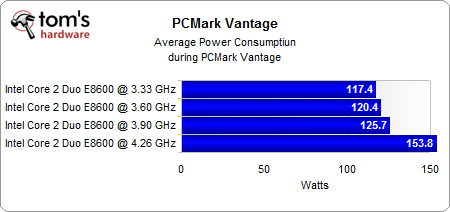Overclocking Core 2 Duo: Power Versus Performance
Power Consumption Results
Idle power is relevant for all users who keep their systems up and running for many hours every day. As you can see, going from 3.33 to 3.9 GHz doesn’t introduce any significant increase in power consumption, and even 4.26 GHz seems acceptable. The 28% clock speed difference (3.33 to 4.26 GHz) results in 23% more idle power.
The differences in peak power are more significant, and the results make obvious that 4.26 GHz at increased voltage comes at a price: 200 W vs. 134 W at stock speed is almost a 50% increase.
Average power consumption during a full PCMark Vantage run was almost comparable for the 3.33, 3.60 and 3.90 GHz settings, while the 4.26 GHz overclock at increased voltage levels led to almost excessive average power requirements.
Increased performance meets increased power consumption. As you can see, the total power used to complete a full PCMark Vantage run was almost the same for the 3.33, 3.6 and 3.9 GHz setting, as performance and power consumption seem to increase in a healthy proportion. However, the highly overclocked system clearly required more power to finish this workload.
Get Tom's Hardware's best news and in-depth reviews, straight to your inbox.
Current page: Power Consumption Results
Prev Page Application Benchmark Results Next Page Efficiency Results


